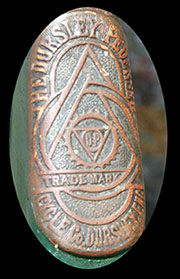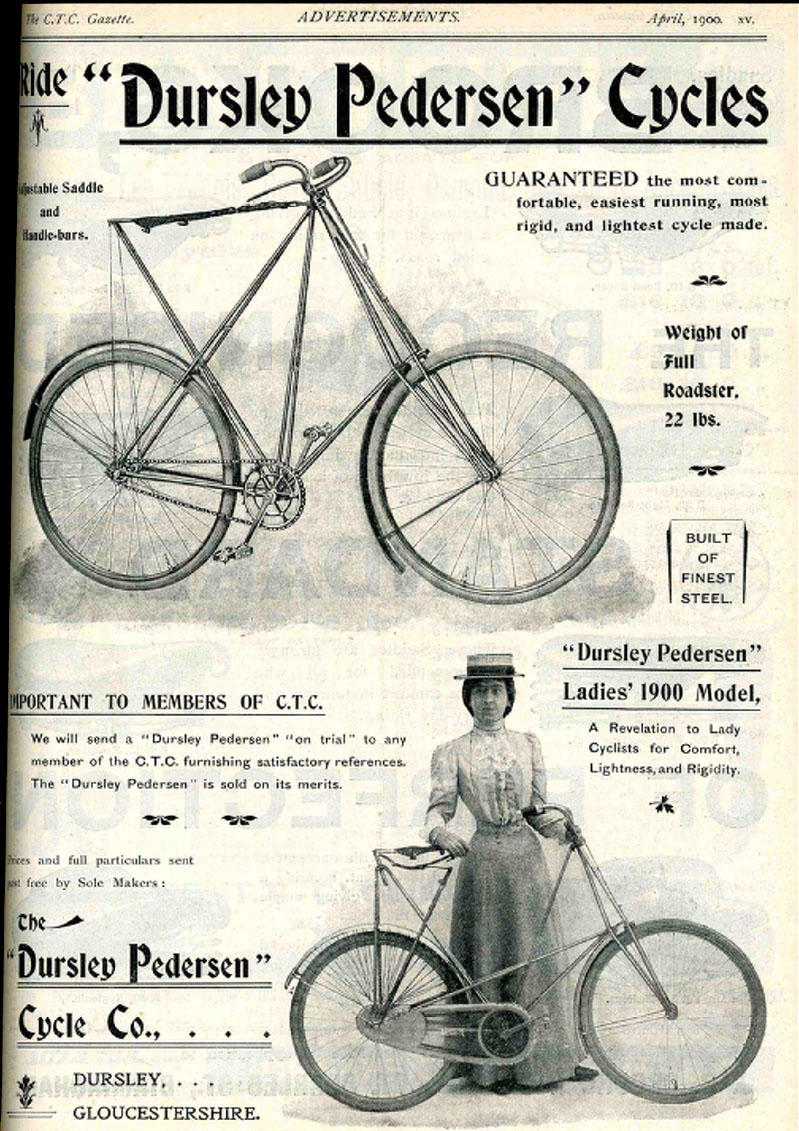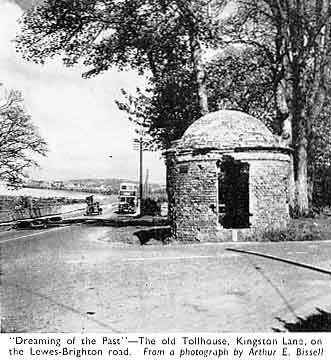

The latest military wheel has been invented by the Dursley-Pedersen Cycle Company of Dursley, Gloucester. The saddle is made of interlaced strings, and derives its shape from a curved steel cantle, between which and the rear point of support are seven spiral springs, giving elasticity to the seat. A strap is used to attach it to the head. The cycle is very light but very strong. The method of construction consists entirely of a system of triangles. The small tubes used are in pairs throughout, each pair making in itself a triangle, and thereby imparting great lateral stability to the machine. Four pairs of these tubes, including the back stays, radiate from the ends of the crank bracket, making this part, which is subject to the greatest stress in driving, adequate to meet every strain. The two pairs of tubes forming the head and front fork are admirably arranged for strength and efficiency. The two front tubes are perfectly straight, whilst the others are drawn back in the centre, where an open steel crown-plate holds all four in position. The above illustrations show the new Detachable Dursley-Pedersen Cycle, carrying Lee-Enfield rifle, cartridge bandolier with 200 rounds of ammunition, bayonet, military overcoat, haversack, mess-tin, water-bottle, and belt. The machine illustrated above is built of steel throughout and weighs under 15lbs.
– ‘The Sphere’ Magazine, 26th May, 1900
While Mikael Pedersen was creating his cycle manufacturing business, the Boer War started. Volunteer cycle corps already existed: this was the first war where bicycles were employed and proved their value. So Pedersen adapted his bicycle for military use, and the prototype ‘Military’ Pedersen created excellent publicity for the company in its first years.
The Dursley Pedersen ‘Folding’ Model was more accurately described by the company as a ‘Detachable.’ The method of fixing the forks to the frame was amended with a ‘quick-release’ lever under the fork crown. So the front fork, with wheel and handlebar intact, could be easily removed and strapped to the rest of the bike for increased portability.
The ‘Military’ model had, in addition, an elaborate rifle clip attached to the front fork. The bicycle was fitted with 24″ wheels, the idea being that the rider could stop the bicycle and, with feet planted firmly on the ground, withdraw the rifle from the clip and shoot. The reality of war, however, meant that if a soldier was under fire, he was more likely to jump off the bike and shoot lying prone the ground or from cover, not while a sitting target on a Dursley Pedersen.
Also, the first prototype ‘Military’ model was weakened when the forks were detached; the exposed frame members could easily be damaged; on subsequent ‘Detachable’ models an extra tube was fitted between them.
The Dursley Pedersen ‘Original’ had an advertised weight of 22lbs. The ‘Detachable’ was sold without mudguards and brakes, which was a common way in the 1890s of reducing the weight of a bicycle. 24″ wheels instead of 28″ would also save weight. At 15lbs, may have been the lightest-weight bicycle available. But the Army did not take up Mikael Pedersen’s Military Detachable Cycle for war use. Although very lightweight and therefore useful for carrying, it was not really robust enough for active service. The folding bicycle models that were actually used by armies – the Captain Gerard in France, the Bianchi in Italy, and similar Austrian and Russian models – were small bicycles with strong frames. The folding BSA adopted by the British army was a full-size roadster.

1900 Dursley Pedersen ‘Detachable’ Military Cycle
24″ Wheels
Frame No 352 size 5
(Now sold)

This 1900 Dursley Pedersen was built around the same time as the first ‘Military’ models. So I’ve adapted it to illustrate a ‘Detachable’ Pedersen.
Instead of Pedersen’s elaborate rifle clip, we’ve fitted a contemporary cavalry rifle holster to the front forks – a far simpler solution, and more practical; it allows the rifle to be pointed downward and therefore drawn for action much faster. It’s a fixed wheel bicycle without brakes. Wheels are 24inch: it’s interesting seeing a standard size frame with smaller wheels, the only example of this set up that I’ve encountered.
I did not want to damage this very early Pedersen ‘Original’ model by replacing the original front fork pivot brackets to replicate the ‘Detachable’ fast-release mechanism. The original brackets, in the photos below, are easily observed once the forks are detached. Those brackets are the only difference between a ‘Detachable’ and standard frame.
This head badge shows ‘Dursley Pedersen & Co.’ The firm was incorporated as a limited company in 1900, so the badge was subsequently changed to show ‘Dursley Pedersen & Co Ltd.’ Records indicate that 250 Pedersens were built up to the financial year ending 1st May 1900, and 2000 the following year. So I would speculate, with that production rate, this Frame No 352 was built in May 1900.





From THE SPHERE, 26th May 1900

















Illustrations and Pedersen information from our ‘bible’ – the excellent book ‘Mr Pedersen: A Man of Genius’ by David Evans.
Photo location is Ashcombe Toll House, which was constructed around 1820 at the eastern end of what was the Lewes-Brighton Turnpike (pictured below in 1951). It’s not exactly a Boer War blockhouse! But is the closest thing I could find in my area.
























